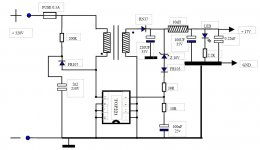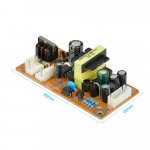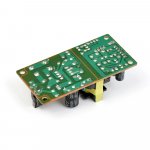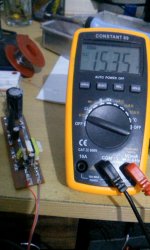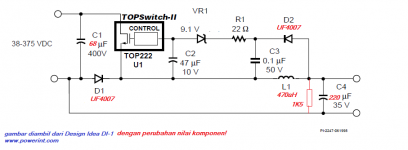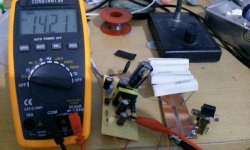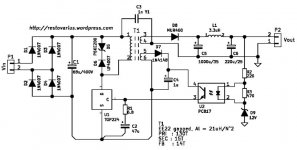Silvio
Well-known member
Here I am presenting an auxiliary power supply meant to be fitted with a SMPS of half or full bridge. The output voltage was chosen to be 17v which is quite ideal for this purpose. However this voltage can be varied to suit the particular need . The TOP221P chip is utilized as this comes in various shapes as 8 pin DIL or TO220. The chip comes also in various wattages such as 9 to 20 watts in DIL and SMD form and 12 to 150 watts in TO220 package. The chip has soft start and also short circuit protection built in.
In my case the output of the chip is not isolated and also the input bridge and bulk capacitor has been omitted as this Aux supply is to be powered from the main bulk capacitor of the smps. The Aux is meant to be fitted on the main pcb.
Operation
The chip incorporates basically 3 terminals which are Drain, source and control. In the DIL format pins 1,2,3 and 6, 7, 8 being the source pins. This is meant for the chip to dissipate the heat to the copper clad of the PCB. Pin 4 is the control and pin 5 is the drain.
With the control pin fitted directly to the output the output voltage is set to 5.6v however this can be varied with the insertion of a zener diode and also with a potential divider. In my case I used both. I used a 10v zener in series with a potential divider and a series diode to trim to the needed voltage of 17 volts. However this voltage can be varied to suit different needs by changing the zener voltage.
The power absorbed was with a maximum of 8 watts 17v and 500mA. Idle power is 1watt
The EE transformer details are as follows
The centre core measurement is 5.7mm X 5.7mm Area 0.32cm^2 and outside dimensions are 20 x 20mm
Gap is 0.15mm (0.006”)
Primary inductance 2.4mH (125 turns 0.16mm ecw) Secondary inductance is 65uH (10 turns 2X 0.4mm ecw)
The PDF file in the bottom can be downloaded with the detailed PCB and component layout and schematic
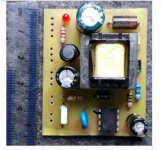
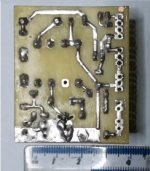
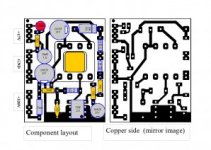
View attachment smps 2k-2 aux.pdf
In my case the output of the chip is not isolated and also the input bridge and bulk capacitor has been omitted as this Aux supply is to be powered from the main bulk capacitor of the smps. The Aux is meant to be fitted on the main pcb.
Operation
The chip incorporates basically 3 terminals which are Drain, source and control. In the DIL format pins 1,2,3 and 6, 7, 8 being the source pins. This is meant for the chip to dissipate the heat to the copper clad of the PCB. Pin 4 is the control and pin 5 is the drain.
With the control pin fitted directly to the output the output voltage is set to 5.6v however this can be varied with the insertion of a zener diode and also with a potential divider. In my case I used both. I used a 10v zener in series with a potential divider and a series diode to trim to the needed voltage of 17 volts. However this voltage can be varied to suit different needs by changing the zener voltage.
The power absorbed was with a maximum of 8 watts 17v and 500mA. Idle power is 1watt
The EE transformer details are as follows
The centre core measurement is 5.7mm X 5.7mm Area 0.32cm^2 and outside dimensions are 20 x 20mm
Gap is 0.15mm (0.006”)
Primary inductance 2.4mH (125 turns 0.16mm ecw) Secondary inductance is 65uH (10 turns 2X 0.4mm ecw)
The PDF file in the bottom can be downloaded with the detailed PCB and component layout and schematic



View attachment smps 2k-2 aux.pdf

